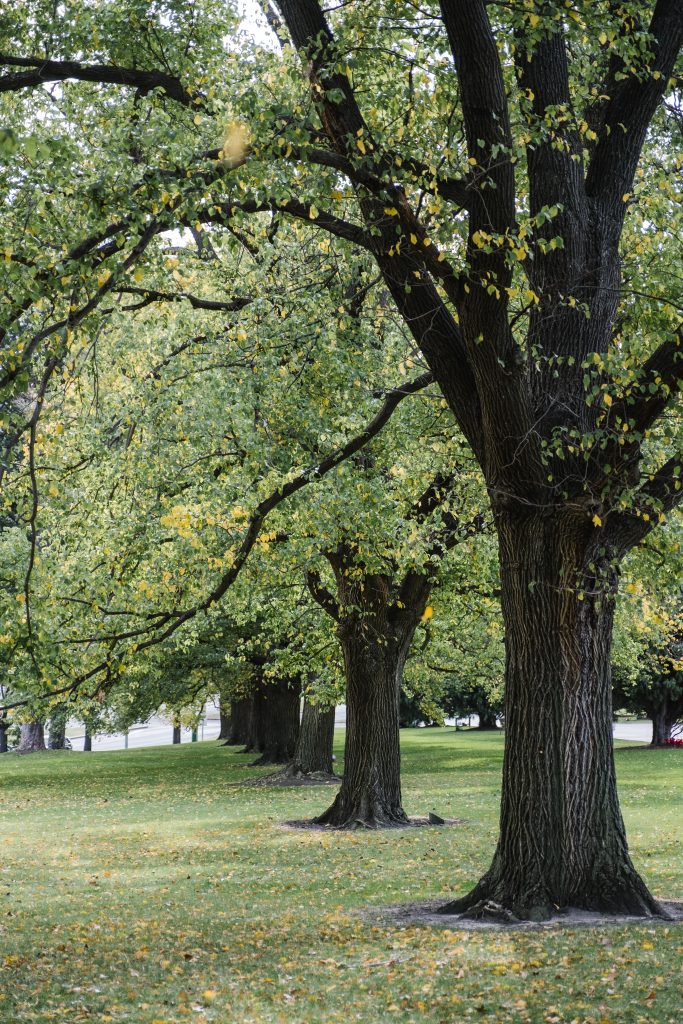THE ROLE OF TREES IN STORMWATER MANAGEMENT
The role of trees in stormwater management is significant and multifaceted. Trees offer a natural and effective solution to mitigate the adverse effects of stormwater runoff in urban and developed areas. By incorporating trees into stormwater management strategies, communities can enhance water quality, reduce flooding, and create more resilient and sustainable environments. Here’s an explanation of the various ways trees contribute to stormwater management:

- Runoff Reduction: Tree canopies intercept and capture rainwater, reducing the volume of water that reaches the ground. This interception slows down the impact of rainfall and reduces the overall amount of runoff generated during storms. As a result, the burden on stormwater infrastructure, such as drainage systems and sewers, is lessened.
- Soil Infiltration Enhancement: Trees play a crucial role in improving soil structure and permeability. Their roots create channels within the soil, allowing rainwater to penetrate more easily. This increased infiltration helps recharge groundwater aquifers and prevents excess runoff from overwhelming drainage systems.
- Water Quality Improvement: Trees act as natural filters, capturing pollutants from stormwater runoff. Leaves, branches, and root systems intercept and retain sediment, heavy metals, nutrients, and other contaminants before they reach water bodies. This filtration process improves the quality of water that eventually flows into streams, rivers, and lakes.
- Erosion Prevention: Tree roots stabilize soil, preventing erosion caused by heavy rainfall and runoff. Their root systems bind the soil particles together, reducing the risk of sedimentation in nearby water bodies. This prevents soil loss and protects streambanks and shorelines from degradation.
- Temperature Regulation: Tree canopies provide shade, reducing soil and surface temperatures. Cooler runoff water results in less thermal pollution when it enters water bodies. Additionally, the shade provided by trees helps mitigate the urban heat island effect, which can exacerbate stormwater issues in densely populated areas.
- Flood Reduction: By reducing runoff volume and slowing the rate of water flow, trees help mitigate flooding during storms. Their role in intercepting rainwater and promoting infiltration reduces the strain on stormwater infrastructure and minimizes the risk of flash floods.
- Green Infrastructure Integration: Trees can be integrated into various green infrastructure practices such as rain gardens, bioswales, and tree trenches. These features are designed to capture, treat, and manage stormwater onsite using natural processes. Trees complement these systems by enhancing their efficiency in reducing runoff and improving water quality.
- Carbon Sequestration: Trees play a role in climate adaptation by sequestering carbon dioxide from the atmosphere. While not directly related to stormwater management, the broader environmental benefits of trees contribute to the overall health and resilience of ecosystems.
- Aesthetic and Recreational Value: Trees contribute to the aesthetic appeal of urban areas, making them more attractive and livable. Well-landscaped areas with trees often encourage community engagement, outdoor activities, and social interactions, contributing to the overall quality of life.
In summary, trees are natural allies in stormwater management efforts. Their ability to intercept rainfall, improve soil quality, enhance water quality, prevent erosion, and reduce flooding makes them invaluable components of sustainable urban planning. Integrating trees into stormwater management strategies not only addresses immediate environmental concerns but also promotes long-term resilience and creates healthier, more resilient communities.
Importance of Discussing Trees as a Natural Solution to Stormwater Issues
Discussing trees as a natural solution to stormwater issues is essential due to the numerous benefits they offer for both the environment and communities. Recognizing and promoting the role of trees in stormwater management can lead to more sustainable and effective urban planning and development. Here’s why discussing trees as a natural solution is important:

- Eco-Friendly Approach: Trees provide a natural and sustainable solution to stormwater challenges, minimizing the need for costly and resource-intensive engineering solutions. This approach aligns with the principles of eco-friendliness and environmental stewardship.
- Resilience in Climate Change: With the increasing frequency and intensity of storms due to climate change, trees can help communities adapt by reducing the impacts of flooding, erosion, and water pollution. Their contribution enhances urban resilience to changing weather patterns.
- Multiple Benefits: Trees offer a multitude of benefits beyond stormwater management, such as carbon sequestration, air quality improvement, and habitat creation. Discussing their role in stormwater management highlights the interconnectedness of these benefits.
- Community Engagement: Fostering a dialogue about trees and stormwater management engages the community in environmental issues. Residents are more likely to support and participate in initiatives that enhance their surroundings and quality of life.
- Cost Savings: Implementing green infrastructure solutions that involve trees can be more cost-effective in the long run compared to traditional gray infrastructure. Trees provide ongoing benefits without the maintenance and energy costs associated with mechanical systems.
- Enhanced Aesthetics: Trees add beauty and visual appeal to urban landscapes. Integrating them into stormwater management solutions improves the aesthetics of public spaces, creating attractive and inviting environments.
- Public Health and Well-being: Trees contribute to improved air quality, reduced heat stress, and a more pleasant outdoor environment. This, in turn, benefits public health and well-being, as people are more likely to spend time outdoors and engage in physical activities.
- Educational Opportunities: Discussing trees as a stormwater solution raises awareness about the importance of trees in urban ecosystems. It provides an opportunity to educate the public about the critical role trees play in maintaining ecological balance.
- Long-Term Sustainability: Trees have the potential to provide benefits for generations to come. Their role in stormwater management contributes to sustainable urban planning that considers the needs of the present and future.
- Policy and Planning Integration: Recognizing trees’ role in stormwater management encourages urban planners, landscape architects, and policymakers to incorporate tree-focused strategies into development plans, zoning codes, and regulations.
- Global Relevance: The discussion of trees as a natural solution to stormwater issues transcends geographic boundaries. Many urban areas worldwide face stormwater challenges, and trees can serve as a universally applicable solution.
- Synergy with Green Movement: The discourse on trees aligns with the broader green movement that seeks to restore and enhance natural ecosystems within urban environments. Trees are emblematic of the shift toward more sustainable and harmonious cities.
Incorporating trees into stormwater management discussions acknowledges their significance in promoting sustainable urban development. This approach not only addresses the pressing issue of stormwater but also contributes to creating more livable, resilient, and environmentally conscious communities.
Benefits of Trees in Stormwater Management
Trees provide numerous benefits in stormwater management, offering natural and effective solutions to mitigate the negative impacts of urban runoff. Incorporating trees into stormwater management strategies can lead to improved water quality, reduced flooding, and enhanced ecosystem health. Here are the key benefits of trees in stormwater management:

- Runoff Reduction: Tree canopies intercept and capture rainwater, reducing the volume of water that reaches the ground. This interception slows down the impact of rainfall and reduces overall runoff during storms. As a result, the burden on stormwater infrastructure, such as drainage systems and sewers, is lessened.
- Soil Infiltration Enhancement: Trees play a vital role in improving soil structure and permeability. Their root systems create channels within the soil, allowing rainwater to penetrate more easily. This increased infiltration helps recharge groundwater aquifers, preventing excess runoff and promoting groundwater recharge.
- Water Quality Improvement: Trees act as natural filters, capturing pollutants from stormwater runoff. Leaves, branches, and root systems intercept and retain sediment, heavy metals, nutrients, and other contaminants before they reach water bodies. This filtration process improves the quality of water that eventually flows into streams, rivers, and lakes.
- Erosion Prevention: Tree roots stabilize soil, preventing erosion caused by heavy rainfall and runoff. Their root systems bind soil particles together, reducing the risk of sedimentation in nearby water bodies. This prevents soil loss and protects streambanks and shorelines from degradation.
- Temperature Regulation: Tree canopies provide shade, reducing soil and surface temperatures. Cooler runoff water results in less thermal pollution when it enters water bodies. Additionally, the shade provided by trees helps mitigate the urban heat island effect, which can exacerbate stormwater issues in densely populated areas.
- Flood Reduction: By reducing runoff volume and slowing the rate of water flow, trees help mitigate flooding during storms. Their role in intercepting rainwater and promoting infiltration reduces the strain on stormwater infrastructure and minimizes the risk of flash floods.
- Carbon Sequestration: While not a direct stormwater benefit, trees contribute to climate adaptation by sequestering carbon dioxide from the atmosphere. This indirect benefit further supports the overall health and resilience of ecosystems.
- Biodiversity and Habitat Creation: Trees attract and provide habitat for various wildlife species. Urban green spaces created by trees enhance biodiversity, create natural habitats, and contribute to overall ecosystem health.
- Aesthetic and Recreational Value: Trees contribute to the aesthetic appeal of urban areas, making them more attractive and livable. Well-landscaped areas with trees often encourage community engagement, outdoor activities, and social interactions, enhancing the overall quality of life.
- Cost-Efficiency: Integrating trees into stormwater management strategies can be more cost-effective in the long run compared to traditional gray infrastructure solutions. Trees provide ongoing benefits with minimal maintenance requirements.
- Enhanced Property Value: Properties with mature trees and well-maintained landscapes tend to have higher real estate values. Trees contribute to a sense of community and provide additional economic value to neighborhoods.
- Education and Awareness: Promoting the benefits of trees in stormwater management raises awareness about the importance of urban green spaces. Educating communities encourages support for tree planting initiatives and environmental conservation efforts.
Incorporating trees into stormwater management practices offers a holistic and sustainable approach that addresses multiple environmental, social, and economic challenges faced by urban areas.


Comments are closed.